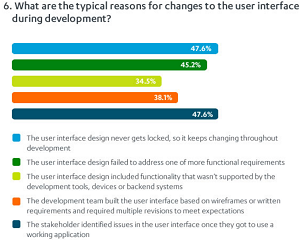News
Survey Shows Mobile Developers Struggling with App UIs
- By David Ramel
- December 11, 2014
A new survey shows problems with UI development cause project delays and cancelations and poor user adoption for apps that do get published.
"The 'Bridging the Gap: Mobile App Design and Development' survey reveals that a traditional approach to mobile application development for enterprises causes friction and misalignment between developers and designers, with 50 percent of respondents saying their projects fail to lock or get approved because of UI issues," said survey sponsor Kony Inc.
The company sells a mobile application development platform and related products and services.
The survey polled two groups -- developers and others who contribute to app concept and design -- and results from the 340 respondents show "business users, designers and developers don't see eye to eye when it comes to UX and interface design, which can cause costly delays and mobile app failures, leaving the business looking for a better answer," said Kony exec Dave Shirk.
Kony said the three main key findings of the survey are:
- UI is the main source of frustration.
- Change requests slow down development time.
- Developers struggle with UI and UX.
Developers complained the UI design never gets locked. "The stakeholder identified issues in the UI once they got to use the working application; and the UI design failed to address one or more functional requirements," Kony said.
 [Click on image for larger view.]
What causes UI changes? (source: Kony Inc.)
[Click on image for larger view.]
What causes UI changes? (source: Kony Inc.)
Nearly half of the survey respondents said projects fail to lock or have the UI approved within the target timeframe, leading to typical app delivery lifecycles lasting four to six months.
According to the survey, "35 percent of respondents said that, when the UI is provided late, complete approval is delayed two to four weeks. Nearly 15 percent said late UI delivery causes a four to six week delay and about 20 percent said it kills the app altogether -- it never gets fully locked or approved."
Respondents from the "contributor" camp cited several challenging aspects to working with developers to create successful apps, with the No. 1 challenge "communicating input back to developers on the mobile app prototype." After that, the main challenges include collaborating with developers during the project cycle, developers not understanding how important UX is, finding a developer who understands how to develop apps with a great UX, and conveying the mobile app design concepts to the developer at the start of the project.
Kony concluded that mobile app developers need to change the usual processes they've been following, echoing findings from other surveys. One way to do that is through more business user DIY projects.
"To streamline the development, mobile app developers will need to employ practices that are vastly different from traditional application development processes, including innovative technology such as 'codeless' and 'easy-to-use design' app solutions, empowering line-of-business [users] to design mobile apps themselves," Kony concluded.
Kony recommended that enterprises partner with Kony to streamline the dev process.
About the Author
David Ramel is an editor and writer at Converge 360.